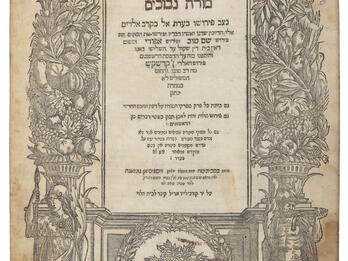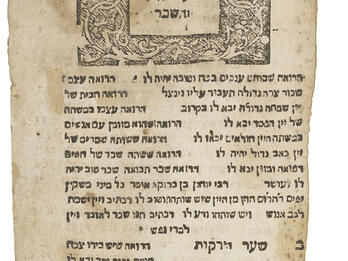Dedication (to Gracia Nasi): Ferrara Bible
Yom Tob Athias
Abraham Usque
1553
It would not seem proper, most magnificent Lady, that now we are about to print the Bible in our Spanish tongue, translated from the Hebrew word for word—so rare a work never before known until our day, it should be offered to persons whose favor could not help it, but to one so noble and magnanimous that it would adorn her nobility. Therefore we…
In Ferrara, Italy, where many conversos fleeing the Iberian Peninsula found refuge, the first full Spanish translation of the Old Testament in Latin characters was published by the translator Abraham ben Solomon Usque and typographer Yom Tob ben Levi Athias (who also funded the endeavor). The translation, intended largely for New Christians who wanted to revert to Judaism but lacked a knowledge of Hebrew, drew heavily on Spanish Jewish translation traditions, thus creating a bridge between the past in Spain and contemporary reality. This Bible, which was reprinted in numerous editions, influenced later Spanish translations of the Bible, was used in many Jewish communities—especially in the Netherlands—and was quoted
by Christian scholars. However, some criticized the translation and its language, particularly the literal translations that closely replicated the Hebrew syntax without regard for Spanish sentence structure. Two versions were printed, one for Jewish audiences, dedicated to Doña Gracia Nasi, the financier of this press, and the other, with a dedication to the Duke of Ferrara, intended for a Christian audience.
Related Guide
Jewish Printing and Book Culture
Jewish printing unified far-flung communities by standardizing religious texts, created textual uniformity, and enabled vernacular translations, and facilitated the spread of Jewish texts and knowledge.
Related Guide
Early Modern Italy: Where East and West Meet
Ashkenazim, Sephardim, and Marranos encountered each other in Italian cities, developing community structures that later influenced Jewish communal organization throughout the western world.
Related Guide
Early Modern Jewish Languages
As Ashkenazi and Sephardi Jews migrated eastward, Yiddish and Ladino emerged as distinct languages. Both languages developed literary traditions, as print became more widespread.
Creator Bio
Yom Tob Athias
Yom Tob Athias, also known as Jeronimo de Vargas, a typographer of Sephardic origin, settled in Ferrara. There, he printed the first full Spanish translation of the siddur (daily prayers; 1552), a translation that was frequently reprinted over coming centuries. Together with another former New Christian of Portuguese origin, Abraham ben Samuel Usque (Duarte Pinel), he printed the first Spanish translation of the Hebrew Bible, which came to be known as the Ferrara Bible (1553).
Creator Bio
Abraham Usque
Abraham ben Samuel Usque (Duarte Pinel) was a New Christian of Portuguese origin who was active as a translator in Ferrara, Italy. Together with printer Yom Tob ben Athias, he produced the first translation of the Hebrew Bible into Spanish, known as the Ferrara Bible (1553).
You may also like
Colophon: Solomon Ibn Gabirol’s Mivḥar ha-peninim
Dedication (to Gracia Nasi): Consolações às Tribulações de Israel
Leḥem Yehudah (The Bread of Judah): On the Fate of the First Edition

Moses Maimonides’ Guide of the Perplexed



